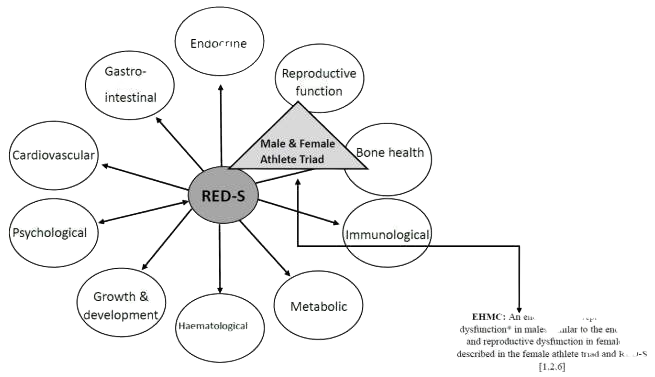Sports nutrition is crucial when it comes to optimising training and performance and the prevention of or recovery from injury. Nutrition for athletes can be compared to fuel for a car. A car must have sufficient fuel in its tank to reach its destination. Moreover, optimal performance requires the right kind of fuel. Adding the wrong fuel can lead to the car breaking down.

Highlights
- Sports nutrition is crucial when it comes to optimising training and performance, and the prevention of or recovery from injury. From a fuelling point of view, the right balance of macronutrients, micronutrients and water is essential,
- Low fueling or low energy availability (LEA) refers to the body’s inability to support regular physiological functions for ideal health due to lack of energy. The International Olympic Committee (IOC) now identifies RED-S as a condition that affects athlete performance,
- As per IOC standards, healthy eating habits with appropriate EA, normal hormonal and metabolic function and healthy bone density are factors that ensure low-risk participation in sports.
From a fueling point of view, the right balance of macronutrients (carbohydrates, proteins, fats), micronutrients (minerals, vitamins) and water is essential for peak performance. Inadequate fueling can impact the body’s ability to optimise resources, thereby affecting performance.
Low energy availability (LEA)
Low fueling or low energy availability (LEA) refers to the body’s inability to support regular physiological functions for ideal health due to lack of energy. When athletes consume fewer calories than needed for health, training and recovery, a condition called relative energy deficiency in sports (RED-S) develops. This impacts many elements of health and performance. The female and male athlete triad and the relative energy deficiency in sports (RED-S) are deeply connected to the concept of energy availability.
Energy availability (EA) is the difference between energy intake (EI) and exercise energy expenditure (EEE), expressed relative to a person’s lean body mass (LBM). In simple terms, it is the number of calories remaining for body functions after deducting for calories used during exercise and recovery.
EA = Dietary energy intake(kcal) − Exercise energy expenditure (kcal)/ fat free mass (kg)
Taking in as few as 300–500 calories below energy needs every day is enough for impairment of performance and health. At the collegiate level, 10–38% of males and 35–58% of females are at risk for disordered eating and low energy availability.
Meeting energy requirements for athletes is challenging, especially teen athletes who are still growing. When an athlete has low EA, performance is impacted, risk of injuries can increase and overall health can be adversely affected. After all, we can’t talk about performance without first taking care of well-being.
Causes of LEA
Studies have indicated that the following individuals are more prone to LEA than others: athletes in sports that require low body weight and athletes who have disordered eating or with eating disorders. Athletes and the general population who alter their diets without professional advice (for goals such as weight loss) can suffer from lower energy intake in the long term.

The impact of LEA on the body and on performance
Low energy availability impacts athletes of both genders and there’s enough knowledge on its implications on health and performance, the International Olympic Committee (IOC) now identifies RED-S and associated physiological impairments, including metabolic rate, immune function, protein synthesis and cardiovascular health.
Bone health is a significant concern in athletes, particularly for growing teens, given that the capacity to build bone mass is at its highest during periods of growth spurts. Insufficient EA can decrease bone mass, and a diet focused on intentionally restricting calories may often lack nutrients essential to bone health such as calcium and vitamin D.
A study of elite endurance athletes training for the 2016 Olympics found that when female athletes missed their menstrual cycles, or men were in the lowest 25 percentile of testosterone levels, they were 4.6 times more at risk for stress fractures. In another study, cyclists with low EA, particularly in the long-term, were found to have adverse quantifiable measures of bone, endocrine and performance consequences of RED-S.
The IOC’s position statement on RED-S identifies multiple adverse effects such as decreased muscle strength, glycogen stores, endurance performance, training response, coordination and concentration, increased injury risk, depression and irritability.
RED-S puts every athlete at risk, even though research on this has primarily been on female athletes. However, low EA can impact testosterone levels in men. Unlike missed menstrual cycles in female athletes, hormonal changes in male athletes may often go unnoticed.
Moderate-risk factors in sports participation include prolonged low-percent body fat, weight loss of 5-10% in a month, changes in expected growth and development in adolescent athletes, abnormal menstrual cycle in females and hormone profile in males, reduction in bone density, a history of one or more stress fractures, physical/psychological complications related to low EA/disordered eating, prolonged relative energy deficiency, and disordered eating behaviours.
As per IOC standards, healthy eating habits with appropriate EA, normal hormonal and metabolic function and healthy bone density are factors that ensure low-risk participation in sports.
Conclusion
Low fuelling or low energy availability is a problem with regards to health and performance. Individuals should follow an appropriate diet and manage the intensity of the workouts which they take up in order to attain optimum performance.
Disclaimer: The contents of this article are for general information and educational purposes only. It neither provides any medical advice nor intends to substitute professional medical opinion on the treatment, diagnosis, prevention or alleviation of any disease, disorder or disability. Always consult with your doctor or qualified healthcare professional about your health condition and/or concerns and before undertaking a new health care regimen including making any dietary or lifestyle changes.
References








